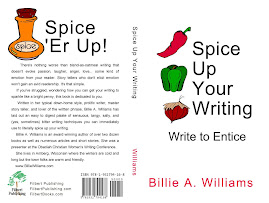
Galleys Are A Scary Thing
By Billie A Williams © 2007
I’ve turned in my Galley’s the last step before publication. The scary part about them is I’ve recently reviewed and passed yea and nay judgments on editorial comments by my editor as well as looking for more corrections myself. So the book is all too familiar to me. I tried reading sentences backwards to be sure I was seeing every word – Of course I read them forward first. I found a few typos that still escaped the editor, copy editor and me. Now the finals are back to me. They are what the world will see January 1, 2008 when they go live on the website.
I held, in the back of my mind, some advice on writing from a book I’ve been reading Hooked, by Les Edgerton. He says in your inciting incident it is not about loud and action packed entry into your story that what you need to hook your reader is rather “The intensity of the wanting is what introduces an element of danger.” Lower the volume he says. I know that is true. If you test it with a roomful of energetic, active youngsters – to get their attention you whisper, you will see the accuracy of this statement.
E.F. Hutton knew long ago what Edgerton expounds to me. Remember that commercial that ran so long ago. If you want to get someone’s attention Whisper. And they whisper “When E.F. Hutton talks, everyone listens.”
Begin with a small moment to create your inciting incident. He uses Thelma and Louise in the movie as an example. I looked at Small Town Secrets my January 2008 release. Chaneeta is removing Valentine decorations at her Cafe and replacing them with the March St. Patrick's Day decorations that remind her of spring when the fire alarm jars her to the present. She is Town Chairwoman as well as a volunteer fire fighter. She is worried about the Barkers’ and their children as she realizes no one will escape now if they aren’t already out of the burning building.
But this isn’t really the inciting incident – the inciting incident occurs when she picks up a rag doll from the periphery of the fire and is immediately transported to an earlier time in her own life. The fire has charred half the doll to black. It brings her mind to her past. Racial slurs spray painted on the family's garden shed wall further deepens her psychological/emotional meaning beyond the fire and the cause of it. What meaning does the black and white doll have for Chaneeta?
The hook is the first brief, potent statement of what is the matter with the central character, what his/her problem is, what difficulty s/he is facing. Edgerton says “…the pulsating pile up of adverbs rarely add the punch that strong, stand alone verbs can.”
A fast start is made with short sentences, paragraphs and quick action or punchy dialog. While a slow start is made by invoking a mood with the description of setting, time or place.
Small Town Secrets starts out slow. Yes another fire rages destroying the home and memories of a family, but the family is safe. The bigger story is reflected in the blaze as graffiti, a racial slur painted on the side of the mixed race family’s garden shed. I believe I started it right. The half white/half black doll is a perfect symbol of what Chaneeta thinks of when she sees the racial slurs. When she gave her illegitimate child up for adoption at her birth, did she leave her to fend for herself against racial slurs and prejudice? Where was she, was she okay. Would Chaneeta ever get over the guilt and pain of leaving her child?
The reader wants to know the circumstances of Chaneeta’s emotional tug of war. This is the inciting incident. I hope it is the one that will pull the reader into the story – hooked until the end. As I read through my galleys for the final time, I had a feeling that if Edgerton was right—I had done exactly what I should have done. I’ve started my book in the right place. Only time will tell, sales will show me if I’ve hooked and held my readers.











1 comment:
I just wrote a review of "Hooked" myself. Unfortunately, I did not take away the same inspiration. Yes, Edgerton advises to turn the volume down. Unfortunately, another book on my shelf--indeed, right next to Edgerton's--advises me to turn the volume UP! This is why I take all of this writing advice with a truckload of salt. You can check out my review on the blog.
-Mark
http://www.writedamnnow.com
Post a Comment